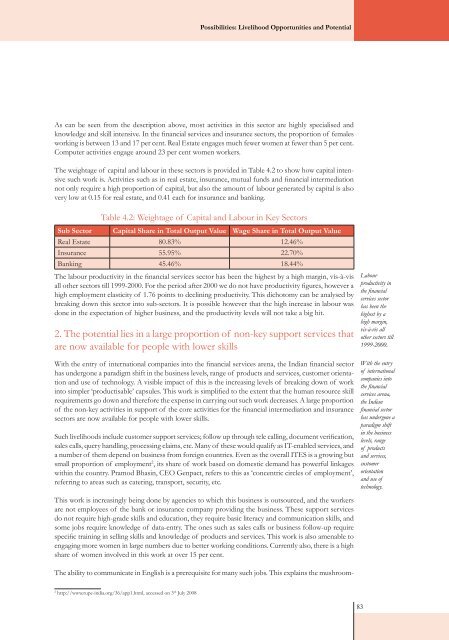SOIL Report 2008 - ACCESS Development Services
SOIL Report 2008 - ACCESS Development Services
SOIL Report 2008 - ACCESS Development Services
Create successful ePaper yourself
Turn your PDF publications into a flip-book with our unique Google optimized e-Paper software.
Possibilities: Livelihood Opportunities and PotentialAs can be seen from the description above, most activities in this sector are highly specialised andknowledge and skill intensive. In the financial services and insurance sectors, the proportion of femalesworking is between 13 and 17 per cent. Real Estate engages much fewer women at fewer than 5 per cent.Computer activities engage around 23 per cent women workers.The weightage of capital and labour in these sectors is provided in Table 4.2 to show how capital intensivesuch work is. Activities such as in real estate, insurance, mutual funds and financial intermediationnot only require a high proportion of capital, but also the amount of labour generated by capital is alsovery low at 0.15 for real estate, and 0.41 each for insurance and banking.Table 4.2: Weightage of Capital and Labour in Key SectorsSub Sector Capital Share in Total Output Value Wage Share in Total Output ValueReal Estate 80.83% 12.46%Insurance 55.95% 22.70%Banking 45.46% 18.44%The labour productivity in the financial services sector has been the highest by a high margin, vis-à-visall other sectors till 1999-2000. For the period after 2000 we do not have productivity figures, however ahigh employment elasticity of 1.76 points to declining productivity. This dichotomy can be analysed bybreaking down this sector into sub-sectors. It is possible however that the high increase in labour wasdone in the expectation of higher business, and the productivity levels will not take a big hit.2. The potential lies in a large proportion of non-key support services thatare now available for people with lower skillsWith the entry of international companies into the financial services arena, the Indian financial sectorhas undergone a paradigm shift in the business levels, range of products and services, customer orientationand use of technology. A visible impact of this is the increasing levels of breaking down of workinto simpler ‘productisable’ capsules. This work is simplified to the extent that the human resource skillrequirements go down and therefore the expense in carrying out such work decreases. A large proportionof the non-key activities in support of the core activities for the financial intermediation and insurancesectors are now available for people with lower skills.Such livelihoods include customer support services; follow up through tele calling, document verification,sales calls, query handling, processing claims, etc. Many of these would qualify as IT-enabled services, anda number of them depend on business from foreign countries. Even as the overall ITES is a growing butsmall proportion of employment 2 , its share of work based on domestic demand has powerful linkageswithin the country. Pramod Bhasin, CEO Genpact, refers to this as ‘concentric circles of employment’,referring to areas such as catering, transport, security, etc.Labourproductivity inthe financialservices sectorhas been thehighest by ahigh margin,vis-à-vis allother sectors till1999-2000.With the entryof internationalcompanies intothe financialservices arena,the Indianfinancial sectorhas undergone aparadigm shiftin the businesslevels, rangeof productsand services,customerorientationand use oftechnology.This work is increasingly being done by agencies to which this business is outsourced, and the workersare not employees of the bank or insurance company providing the business. These support servicesdo not require high-grade skills and education, they require basic literacy and communication skills, andsome jobs require knowledge of data-entry. The ones such as sales calls or business follow-up requirespecific training in selling skills and knowledge of products and services. This work is also amenable toengaging more women in large numbers due to better working conditions. Currently also, there is a highshare of women involved in this work at over 15 per cent.The ability to communicate in English is a prerequisite for many such jobs. This explains the mushroom-2http://www.rupe-india.org/36/app1.html, accessed on 3 rd July <strong>2008</strong>83














